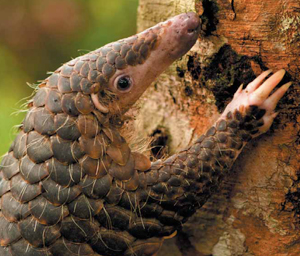|
|
While their trade has been prohibited under the Convention on International Trade in Endangered Species of Wild Fauna and Flora (CITES) since 2002, Asian pangolin populations are rapidly declining due to poaching for use in traditional Chinese medicine, report conservationists. Trade has nearly wiped out the species in Cambodia, Viet Nam and Laos, once strongholds for the scaly, toothless anteater.
“China has a long history of consuming pangolin as meat and in traditional medicine,” the report, published by the wildlife trade monitoring network, TRAFFIC, states. “Due to continual demand and the decreasing Chinese wild population, in the past few years pangolin smuggling from Southeast Asia has resulted in great declines in these producing countries’ wild populations, as well.”
|
|
TRAFFIC says pangolins are the most frequently encountered mammals seized from illegal traders in Asia. Recent hauls include 24 tons of frozen pangolins from Sumatra, Indonesia, seized in Viet Nam this March and 14 tonnes of frozen animals seized in Sumatra this April.
“Pangolin populations clearly cannot stand the incessant poaching pressure, which can only be stopped by decisive government-backed enforcement action in the region,” said Chris Shepherd, Acting Director for TRAFFIC Southeast Asia.
The report notes that an important service performed by pangolins is at risk from over-collection.
“Pangolins save us millions of dollars a year in pest destruction,” said Dr Simon Stuart, Chair of the IUCN Species Survival Commission. “These shy creatures provide a vital service and we cannot afford to overlook their ecological role as natural controllers of termites and ants.”
Slowing international trade in pangolin will require “better enforcement of existing national and international laws designed to protect pangolins, better monitoring of the illegal trade, and basic research to find where viable pangolin populations still exist and whether ravaged populations can recover given adequate protection,” according to TRAFFIC.
The report is available online in PDF form at PROCEEDINGS OF THE WORKSHOP ON TRADE AND CONSERVATION OF PANGOLINS NATIVE TO SOUTH AND SOUTHEAST ASIA.
TRAFFIC is a joint program of WWF and IUCN.
Sandrine Pantel and Chin Sing Yun (ed.). 2009. Proceedings of the Workshop on Trade and Conservation of Pangolins Native to South and Southeast Asia, 30 June-2 July 2008, Singapore Zoo, Singapore. TRAFFIC Southeast Asia, Petaling Jaya, Selangor, Malaysia
Related articles
Illegal hunting in Laos takes toll on wildlife

(04/20/2009) Deep in the rugged mountains of Nam Et-Phou Louey National Protected Area (NEPL) on the Laos–Vietnam border, men smoke cigarettes and talk in hushed voices as they tramp through the forest. Approaching a baited trap, they hear the frantic snarls of an ensnared tiger. The tiger hangs by its front foot, suspended by a cable attached to a tree. The men shoot and make quick work of the tiger, removing its bones but leaving some of its carcass, including parts of its pelt, behind. The real money is no longer in tiger skins, but bones: the 10 to 12 kilograms of bone harvested from the adult tiger will yield $12,000-$15,000 in a region where per capita income is around $400 a year. Though the authorities are able to trace the weapon shells back to their village and locals know of the hunters’ haul, two years later the evidence has not been enough to hold the men accountable for their crimes.
Illegal wildlife trade devastating Asia’s pangolins
(10/15/2008) Last week the IUCN changed the status of the Malayan and the Chinese pangolins from near-threatened to endangered. These notoriously shy and scaly mammals, resembling anteaters with armored plates, have become the victim of a booming illegal wildlife trade in Southeast Asia.
